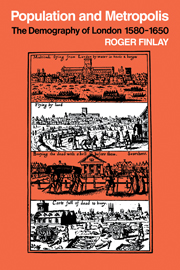Book contents
- Frontmatter
- Contents
- List of tables
- List of figures
- Preface
- 1 Introduction: The magnet of the metropolis
- 2 The accuracy of the London parish registers
- 3 The general growth of population in London
- 4 London social structure in 1638
- 5 The measurement of mortality rates
- 6 The effect of plague on mortality experience
- 7 Marriage and fertility
- 8 Population and metropolis
- Appendix 1 The London bills of mortality
- Appendix 2 Baptisms and burials in sample London parishes
- Appendix 3 Details from the 1638 listing and administrative divisions of London
- Appendix 4 London population in 1631 and houses in 1638 by wards
- References
- Index
1 - Introduction: The magnet of the metropolis
Published online by Cambridge University Press: 06 July 2010
- Frontmatter
- Contents
- List of tables
- List of figures
- Preface
- 1 Introduction: The magnet of the metropolis
- 2 The accuracy of the London parish registers
- 3 The general growth of population in London
- 4 London social structure in 1638
- 5 The measurement of mortality rates
- 6 The effect of plague on mortality experience
- 7 Marriage and fertility
- 8 Population and metropolis
- Appendix 1 The London bills of mortality
- Appendix 2 Baptisms and burials in sample London parishes
- Appendix 3 Details from the 1638 listing and administrative divisions of London
- Appendix 4 London population in 1631 and houses in 1638 by wards
- References
- Index
Summary
The population history of London was the subject of the first major demographic treatise in English, John Graunt's Natural and political observations and conclusions made upon the bills of mortality, first published in 1662. Thus the London statistics have always been closely connected with the origins of historical demography in England. The bills of mortality consist of aggregate totals of baptisms and burials for the whole of London, compiled weekly from the individual Anglican parish registers by the Company of Parish Clerks to advise the city authorities of the onset of plague epidemics. The main series which now survives is of annual totals and these were used by Graunt. He explained that the object of his enquiry was:
to look out all the bills I could, … the which, when I had reduced into tables … so as to have a view of the whole together, in order to the more ready comparing of one year, season, parish, or other division of the city, with another, in respect of all the burials, and christenings, and of all the diseases, and casualties happening in each of them respectively.
Graunt was a relatively ordinary London tradesman, and he tried in his book to convey his understanding of what was happening in his native city during the first half of the seventeenth century. The book was published only three years before the last plague epidemic, and so it appeared at the end of the period for which its conclusions were valid.
- Type
- Chapter
- Information
- Population and MetropolisThe Demography of London 1580–1650, pp. 1 - 19Publisher: Cambridge University PressPrint publication year: 1981



